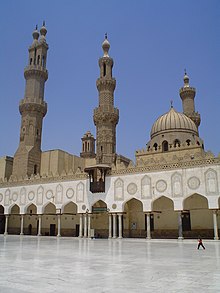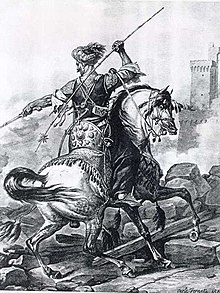Egypt in the Middle Ages
| History of Egypt |
|---|
 |
|
|
| Historical Arab states and dynasties |
|---|
 |
Following the
In 1174, Egypt came under the rule of the
Early Islamic period
Muslim conquest of Egypt

In 639 an army of some 4,000 men were sent against Egypt by the second caliph,
Administration of early Islamic Egypt
Following the first surrender of Alexandria, Amr chose a new site to settle his men, near the location of the Byzantine fortress of
The main pillar of the early Muslim rule and control in the country was the military force, or jund, staffed by the Arab settlers. These were initially the men who had followed Amr and participated in the conquest.[8] The followers of Amr were mostly drawn from Yamani (south Arabian) tribes, rather than the northern Arab (Qays i) tribes, who were scarcely represented in the province; it was they who dominated the country's affairs for the first two centuries of Muslim rule.[3] Initially, they numbered 15,500, but their numbers grew through emigration in the subsequent decades. By the time of Caliph Mu'awiya I (r. 661–680), the number of men registered in the army list (diwān al-jund) and entitled an annual pay (ʿaṭāʾ) reached 40,000. Jealous of their privileges and status, which entitled them to a share of the local revenue, the members of the jund then virtually closed off the register to new entries.[9][8] It was only after the losses of the Second Fitna that the registers were updated, and occasionally, governors would add soldiers en masse to the lists as a means to garner political support.[10]
In return for a very small tribute of money (0.5% Jizya Tax on some free men) and food for the troops, the Christian inhabitants of Egypt were excused from military service and left free in the observance of their religion and the administration of their affairs.
Conversions of
Umayyad period
During the
Abbasid period
The
A major change came in 834, when Caliph
Tulunid period

In 868, Caliph
The first years of Ibn Tulun's governorship were dominated by his power struggle with the powerful head of the fiscal administration, the
Ibn Tulun's rise was facilitated by the feebleness of the Abbasid government, threatened by the rise of the

At Ibn Tulun's death, Khumarawayh, with the backing of the Tulunid elites, succeeded without opposition.
Second Abbasid period and Ikhshidid period
The Abbasids were able to repulse
.In 935, after repulsing another Fatimid attack, the Turkish commander
Fatimid period
This section needs additional citations for verification. (November 2019) |

Meanwhile, the caliph in 2
The Carmathians were gradually forced to retreat from Egypt and then from Syria by some successful engagements, and by the judicious use of bribes, whereby dissension was sown among their leaders. Al-Muizz also found time to take some active measures against the Byzantines, with whom his generals fought in Syria with varying fortune. Before his death he was acknowledged as Caliph in Mecca and Medina, as well as Syria, Egypt and North Africa as far as Tangier.
Under the
, but this was prevented by the intervention of the Byzantines. His North African possessions were maintained and extended, but the recognition of the Fatimid caliph in this region was little more than nominal.
His successor
A more reputable expedient with the same end in view was the construction of a great library in Cairo, with ample provision for students; this was modelled on a similar institution at Baghdad. For unknown reasons al-Hakim disappeared in 1021.
In 1049 the
During the
In 1118 Egypt was invaded by
In 1153
In December 1162, the vizier
Two years later Shirkuh, a Kurdish general known as "the Lion", persuaded Nureddin to put him at the head of another expedition to Egypt, which left Syria in January 1167; a Frankish army hastened to Shawar's aid. At the battle of Babain (April 11, 1167) the allies were defeated by the forces commanded by Shirkuh and his nephew Saladin, who was made prefect of Alexandria, which surrendered to Shirkuh without a struggle. In 1168 Amalric invaded again, but Shirkuh's return caused the Crusaders to withdraw.
Shirkuh was appointed vizier but died of indigestion (March 23, 1169), and the Caliph appointed Saladin as successor to Shirkuh; the new vizier professed to hold office as a deputy of Nureddin, whose name was mentioned in public worship after that of the Caliph. Nureddin loyally aided his deputy in dealing with Crusader invasions of Egypt, and he ordered Saladin to substitute the name of the Abbasid caliph for the Fatimid in public worship. The last Fatimid caliph died soon after in September, 1171.
Ayyubid period
Saladin, a general known as "the Lion", was confirmed as Nureddin's deputy in Egypt, and on the death of Nureddin on April 12, 1174, he took the title
Saladin's son Othman succeeded him in Egypt in 1193. He allied with his uncle (Saladin's brother) Al-Adil I against Saladin's other sons, and after the wars that followed, Al-Adil took power in 1200. He died in 1218 during the siege of Damietta in the Fifth Crusade, and was succeeded by Al-Kamil, who lost Damietta to the Crusaders in 1219. However, he defeated their advance to Cairo by flooding the Nile, and they were forced to evacuate Egypt in 1221. Al-Kamil was later forced to give up various cities in Palestina and Syria to Frederick II, Holy Roman Emperor during the Sixth Crusade, in order to gain his help against Damascus.
Mamluk Egypt

The Mamluk's violent approach to power brought them great political and economic prosperity and led them to becoming the rulers of Egypt.[50] The Mamluk Egypt period began with the Bahri Dynasty and was followed by the Burji Dynasty. The Bahri Dynasty would rule from 1250 to 1382, while the Burji dynasty would last from 1382 to 1517.[50]
Cultural contributions of the Mamluk Empire spanned across more than religion. Literature and astronomy were two subjects which the Mamluks valued and participated in heavily.[51] They were a highly literate and educated society. Private libraries were a status symbol in Mamluk culture. Some of the libraries discovered show evidence of the remnants of thousands of books.
The end of the period was brought about due to famine, military tensions, disease, and high taxation.
Bahri dynasty
Qutuz defeated the army of
Due to the
Since 1347 the Egyptian population, economy, and political system experienced significant destruction as a result of the Black Death pandemic whose waves continued to destroy Egypt up to the early 16th century.

In 1377 a revolt in Syria spread to Egypt, and the government was taken over by the
Burji dynasty
The Burji dynasty (1382–1517) proved especially turbulent, with political power-plays resulting in short-lived sultans. During the period, the Mamluks fought
Plague epidemics continued to ruin Egypt when it spread over the region in 1388–1389, 1397–1398, 1403–1407, 1410–1411, 1415–1419, 1429–1430, 1438–1439, 1444–1449, 1455, 1459–1460, 1468–1469, 1476–1477, 1492, 1498, 1504–1505 and 1513–1514.[53]
Constant political bickering contributed to the inability to resist the
See also
References
- ^ )
- )
- ^ a b Kennedy 1998, p. 64.
- ^ Athamina 1997, p. 102.
- ^ Athamina 1997, pp. 101–102.
- ^ Athamina 1997, pp. 102–103.
- ^ Kennedy 1998, pp. 65–66.
- ^ a b Athamina 1997, p. 104.
- ^ Kennedy 1998, pp. 64–65.
- ^ Athamina 1997, pp. 104–105.
- ^ Kennedy 1998, p. 69.
- ^ Kennedy 1998, p. 70.
- ^ Kennedy 1998, pp. 65, 70–71.
- ^ Kennedy 1998, p. 71.
- ^ Kennedy 1998, pp. 71–72.
- ^ Kennedy 1998, p. 73.
- ^ Kennedy 2004, pp. 158–159.
- ^ Brett 2010, pp. 550–556.
- ^ Brett 2010, p. 557.
- ^ Bianquis 1998, pp. 92–93.
- ^ Brett 2010, p. 558.
- ^ Bianquis 1998, p. 93.
- ^ Brett 2001, pp. 146–147.
- ^ Bianquis 1998, p. 91.
- ^ Bianquis 1998, pp. 89–92, 96.
- ^ Kennedy 2004, pp. 312ff..
- ^ Brett 2010, pp. 565ff..
- ^ Bianquis 1998, p. 92.
- ^ Bianquis 1998, pp. 92, 94.
- ^ Brett 2010, pp. 559–560.
- ^ Bianquis 1998, pp. 99–100.
- ^ a b Bianquis 1998, p. 97.
- ^ Kennedy 2004, pp. 206–208.
- ^ a b Brett 2010, p. 560.
- ^ Bianquis 1998, p. 98.
- ^ Bianquis 1998, pp. 94–95.
- ^ Bianquis 1998, pp. 95–99.
- ^ Bianquis 1998, pp. 100–102.
- ^ Bianquis 1998, pp. 102–103.
- ^ Bianquis 1998, p. 104.
- ^ Bianquis 1998, pp. 104–105.
- ^ Bianquis 1998, pp. 105–106.
- ^ Kennedy 2004, p. 310.
- ^ Bianquis 1998, pp. 106–108.
- ^ Kennedy 2004, pp. 184–185, 310.
- ^ Bianquis 1998, p. 112.
- ^ Kennedy 2004, pp. 312–313.
- ^ Bianquis 1998, pp. 115–118.
- ISBN 0-8052-0898-4.
- ^ OCLC 144525826.
- OCLC 144525826.
- ^ Lane-Poole, Stanley (1901). A History of Egypt in the Middle Ages. Cambridge, Massachusetts: Methuen. pp. 243–254.
- ISBN 5484005604
- ISBN 9780816062591.
Sources
- Athamina, Khalil (1997). "Some Administrative, Military, and Socio-Political Aspects of Early Muslim Egypt". In Lev, Yaacov (ed.). War and Society in the Eastern Mediterranean: 7th–15th Centuries. Leiden: BRILL. pp. 101–114. ISBN 90-04-10032-6.
- ISBN 0-521-47137-0.
- ISBN 978-0-521-83823-8.
- Brett, Michael (2001). The Rise of the Fatimids: The World of the Mediterranean and the Middle East in the Fourth Century of the Hijra, Tenth Century CE. The Medieval Mediterranean. Vol. 30. Leiden: BRILL. ISBN 90-04-11741-5.
- Brett, Michael (2010). "Egypt". In ISBN 978-0-521-83823-8.
- Halm, Heinz (1996). The Empire of the Mahdi: The Rise of the Fatimids. Handbook of Oriental Studies. Vol. 26. transl. by Michael Bonner. Leiden: BRILL. ISBN 90-04-10056-3.
- ISBN 0-521-47137-0.
- ISBN 0-582-40525-4.
- Petry, Carl F. (1994). Protectors or Praetorians? : The Last Mamluk Sultans and Egypt's Waning As a Great Power. Albany: State University of New York Press. ISBN 9780791421390.
